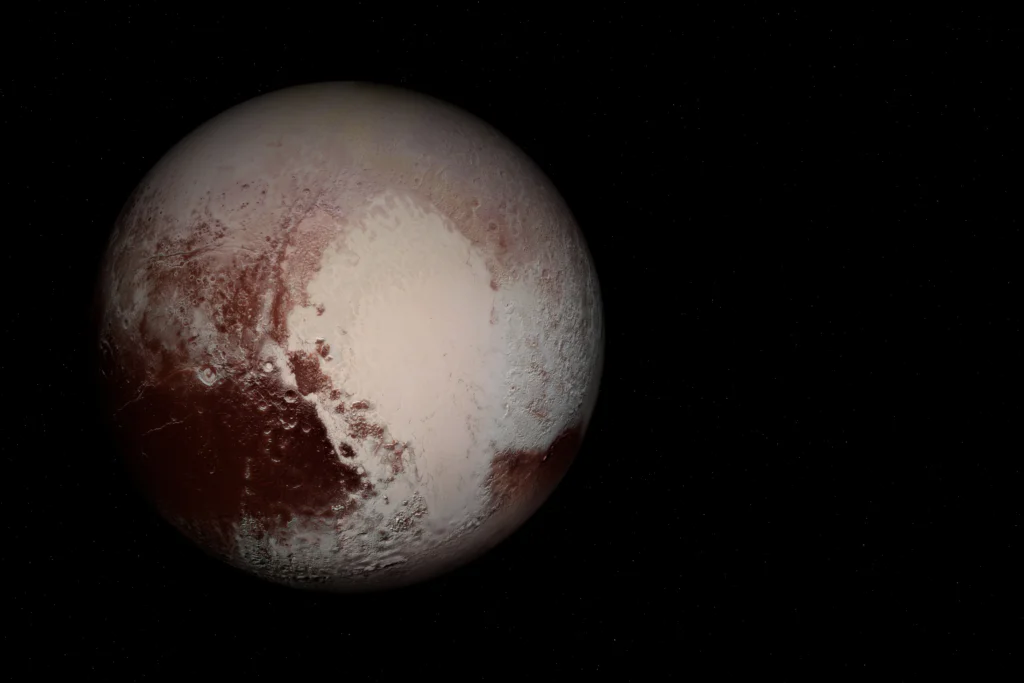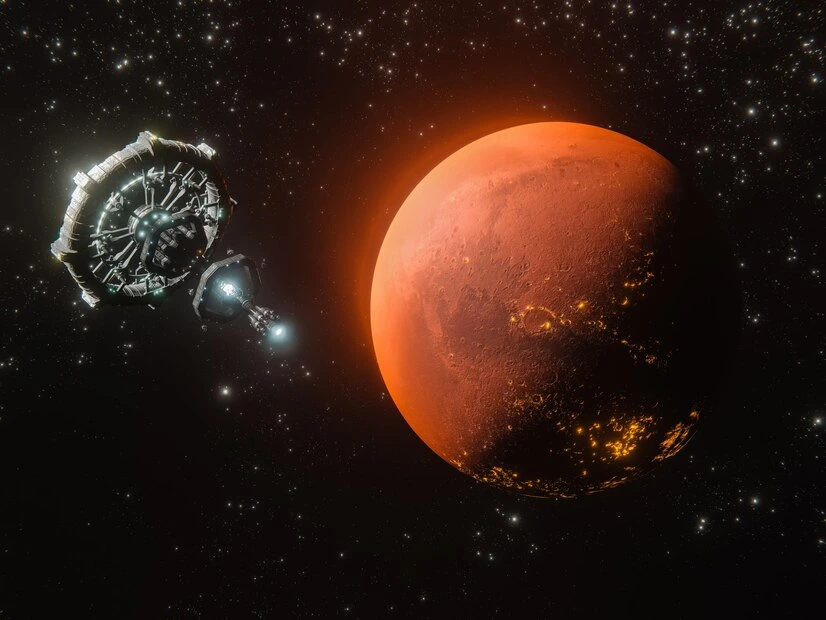In a groundbreaking discovery that’s captivating scientists and space enthusiasts alike, astronomers have detected what could be a sign of life on a planet far beyond our solar system. The planet, known as K2-18b, lies over 120 light-years away – and yet, thanks to the powerful James Webb Space Telescope, researchers have spotted something extraordinary in its atmosphere: a chemical compound that, on Earth, is only produced by living organisms.
While it’s too early to confirm extraterrestrial life, this detection marks one of the most promising leads in the search for life beyond Earth. So what exactly did scientists find – and what does it mean for the future of space exploration? Let’s break it down.

The Discovery That Shook the Scientific World
In September 2023, the astronomical community was stunned by a discovery that may one day be considered a turning point in our search for life beyond Earth. Scientists using the James Webb Space Telescope (JWST) detected a possible biosignature on K2-18b, a planet more than 120 light-years away. Here’s a closer look at what makes this finding so groundbreaking.
How Astronomers Detected Potential Signs of Life on K2-18b
Using the JWST’s highly advanced infrared spectrograph, astronomers were able to analyze the chemical composition of K2-18b’s atmosphere as starlight passed through it. During this process, they detected the presence of dimethyl sulfide (DMS) – a molecule that, on Earth, is exclusively associated with biological activity, particularly from phytoplankton in oceans. This raised immediate excitement, as DMS could hint at the presence of microbial life.
The Role of the James Webb Space Telescope in This Breakthrough
The James Webb Space Telescope, launched in 2021, has revolutionized our ability to study exoplanets. Unlike its predecessor, the Hubble Space Telescope, JWST can observe in infrared with unprecedented precision. Its sensitivity allows scientists to detect trace gases in faraway atmospheres, even when the planet is light-years away. Without JWST, this discovery would not have been possible.
The Importance of Dimethyl Sulfide (DMS) in the Search for Life
DMS is not just another gas. On Earth, it’s produced almost exclusively by marine organisms, and its detection elsewhere could suggest similar biological processes. While scientists remain cautious and consider the possibility of non-biological sources, the detection of DMS alongside methane and carbon dioxide adds weight to the theory that something biological might be happening on K2-18b.
Initial Reactions from the Scientific Community
The response has been a mix of excitement and scientific skepticism. Astrobiologists and planetary scientists have emphasized that while this is a major milestone, more data is needed before claiming definitive proof of life. Researchers have already scheduled follow-up observations to confirm the findings and rule out any false positives.
As Dr. Nikku Madhusudhan from the University of Cambridge, the lead scientist behind the study, put it:
“We are not claiming we’ve discovered life, but we are saying this is a promising sign that warrants further investigation.”

Meet K2-18b: The Mysterious Distant Planet
Nestled more than 120 light-years away in the constellation Leo, K2-18b is a planet that has captured the imaginations of scientists and space enthusiasts alike. While this world has been studied for some time, the recent detection of possible biosignatures in its atmosphere has thrust it into the spotlight. But what makes K2-18b such an intriguing candidate in the search for extraterrestrial life? Let’s explore the unique features that set this planet apart.
Where Is K2-18b Located?
K2-18b is part of a growing list of exoplanets that orbit stars beyond our solar system. It resides in the habitable zone of a red dwarf star, which is much cooler and dimmer than our Sun. The planet itself is a super-Earth, which means it’s larger than Earth but still within a range that could potentially support life. While its exact characteristics still need further study, it’s positioned in what’s known as the Goldilocks Zone — not too hot, not too cold, just right for liquid water to exist.
At a distance of 120 light-years, K2-18b is relatively close in astronomical terms, making it one of the more accessible targets for research in the search for alien life. The fact that it resides within this habitable zone is what initially drew attention to its potential.
What Makes K2-18b Different from Earth?
Although K2-18b shares some characteristics with Earth, such as its location in the habitable zone and its potential to harbor liquid water, it also has many distinct differences. First, it is approximately 8.6 times more massive than Earth, which classifies it as a super-Earth. It also has a much thicker atmosphere, which could contain water vapor and other gases like methane and carbon dioxide.
The planet’s surface conditions are still unknown, but scientists speculate that its atmosphere could be rich in clouds, and the surface might be covered by deep oceans, making it a potentially suitable environment for microbial life. However, whether K2-18b has a rocky surface like Earth, or something more alien, remains a mystery.
Why Is K2-18b So Interesting to Scientists?
K2-18b stands out for several reasons, starting with its potential to support life. Being located in the habitable zone of its star means that liquid water might exist on its surface or in its atmosphere — a key ingredient for life as we know it.
What makes it particularly exciting is the recent discovery of biosignature gases in its atmosphere, including dimethyl sulfide (DMS), a compound linked to life on Earth. Scientists believe that this, combined with other chemicals like methane and carbon dioxide, could indicate that some form of biological activity is occurring on K2-18b.
Moreover, K2-18b’s location near the star’s habitable zone places it in the ideal region for future investigations. With the advanced technology of the James Webb Space Telescope (JWST), researchers are now able to observe and study the planet’s atmospheric composition in greater detail than ever before.
A Glimpse Into the Future of Space Exploration
K2-18b has become a prime target in the ongoing search for extraterrestrial life. As more data comes in, scientists hope to build a clearer picture of what this distant world is like. Future observations, along with new technology like next-generation space telescopes, could reveal even more clues about its potential to harbor life.
While we’re still far from confirming the presence of life on K2-18b, the discovery of this planet and its potential habitability represents an exciting chapter in humanity’s quest to understand whether we are truly alone in the universe.

What Is Dimethyl Sulfide (DMS) and Why Does It Matter?
Dimethyl sulfide (DMS) has recently taken center stage in the search for extraterrestrial life. This compound, which was detected in the atmosphere of the distant exoplanet K2-18b, holds the potential to transform our understanding of life beyond Earth. So, what exactly is DMS, and why does its presence on an alien world carry such significance? Let’s break it down.
What Is Dimethyl Sulfide (DMS)?
Dimethyl sulfide (DMS) is a sulfur-containing organic compound that is primarily produced on Earth by marine microorganisms, including phytoplankton. These microscopic organisms, found in the oceans, release DMS as part of their metabolic processes. On Earth, DMS is responsible for the characteristic smell of the sea, and it plays a key role in the Earth’s sulfur cycle, helping to regulate the environment by acting as a cloud-forming agent.
DMS is also significant because it’s a relatively simple compound, but its presence in an atmosphere is strongly associated with biological activity. In essence, if we detect DMS on a distant planet, it’s often considered a potential indicator of life.
DMS and Its Connection to Life on Earth
On Earth, DMS is almost exclusively associated with biological processes, specifically from marine organisms such as phytoplankton and other sea life. The production of DMS involves the breakdown of organic matter in the oceans, making it a reliable biosignature for life. Phytoplankton, algae, and even some types of bacteria emit DMS as part of their natural processes.
Because DMS is only produced by living organisms on Earth (with few exceptions), scientists have long viewed its presence as a potential sign of biological activity. Thus, the detection of DMS in the atmosphere of an exoplanet like K2-18b is compelling. Could it point to a similar biological origin, or is there another explanation?
Why Does the Discovery of DMS Matter on K2-18b?
The recent detection of DMS in the atmosphere of K2-18b, made possible by the James Webb Space Telescope (JWST), has opened up new possibilities for astrobiology. Here’s why it matters:
- Potential Indicator of Life:
The primary reason for excitement is that DMS is strongly associated with life on Earth. While there are some non-biological ways DMS could be produced, the vast majority of DMS found on Earth is biological in origin. Its detection on K2-18b raises the possibility that the planet could support some form of life, possibly microbial. - Supporting the Case for Habitability:
K2-18b is located in the habitable zone of its star, which means liquid water could exist on its surface. Water, along with the presence of DMS, strengthens the hypothesis that this planet could have the right conditions to support life, similar to how Earth sustains its own ecosystems. - A Step Toward Understanding Exoplanet Atmospheres:
Detecting DMS adds to our growing understanding of the atmospheric composition of distant exoplanets. Scientists now have one more piece of the puzzle, as they work to determine the potential habitability of planets outside our solar system. If other signs of life are found in the future, it could radically change our approach to finding and identifying life beyond Earth.
Could DMS Have a Non-Biological Origin?
While DMS is primarily linked to biological processes, there are a few non-biological scenarios that could produce it. For example, certain chemical reactions involving volcanic activity or other geophysical processes might generate DMS. However, these explanations are far less likely than biological origins, especially when we consider that methane and carbon dioxide—two other biosignature gases—were also detected on K2-18b.
Researchers will need to conduct further observations to rule out other possibilities and confirm whether DMS on K2-18b truly comes from biological sources. This would require not only analyzing the atmosphere’s composition over time but also comparing the levels of DMS to known non-biological processes.
What’s Next for DMS and the Search for Life?
The detection of DMS is just the beginning. Scientists are already planning further investigations into the atmosphere of K2-18b and other exoplanets in the habitable zone. As more data is collected, researchers hope to uncover additional biosignatures or gather further evidence that life exists—or once existed—on distant worlds.
This discovery opens the door to new research possibilities, potentially allowing scientists to refine their search for life in the universe. If DMS is confirmed as a definitive marker of life beyond Earth, it could revolutionize the way we look at other exoplanets, and lead us one step closer to answering the question, “Are we alone in the universe?”

The Role of the James Webb Space Telescope (JWST)
The James Webb Space Telescope (JWST) is often described as a game-changer for astronomy, and its role in the discovery of possible signs of life on the distant exoplanet K2-18b is a prime example of why. Launched in 2021, the JWST is the most powerful space telescope ever built, designed to study the universe in infrared. It is now playing a crucial role in detecting and analyzing distant exoplanets, making it a vital tool in the search for extraterrestrial life.
How JWST Observes Distant Exoplanets
Unlike visible light telescopes, JWST is optimized for infrared observation, allowing it to detect wavelengths of light that are invisible to the human eye. This is especially important for studying distant exoplanets like K2-18b, which orbit far away from Earth and are often shrouded in layers of clouds or gases. By analyzing the infrared light that passes through an exoplanet’s atmosphere, JWST can uncover a wealth of information about its composition.
JWST uses its Near-Infrared Spectrograph (NIRSpec) and Mid-Infrared Instrument (MIRI) to capture spectra — essentially the “fingerprints” — of the light filtered through an exoplanet’s atmosphere. These spectra provide scientists with a detailed chemical analysis, identifying specific gases that make up the planet’s atmosphere. This ability to study the atmosphere in such detail is what made the detection of dimethyl sulfide (DMS) and other biosignature gases on K2-18b possible.
The JWST’s Precision in Detecting Biosignatures
One of the main goals of the JWST is to search for biosignatures — signs of life beyond Earth. Biosignatures can be gases or compounds in an exoplanet’s atmosphere that are associated with biological activity. The detection of DMS on K2-18b is an excellent example of JWST’s ability to spot such signatures with precision.
JWST’s extraordinary sensitivity allows it to detect even trace amounts of specific gases, which is crucial for studying distant planets. For example, while methane, carbon dioxide, and water vapor have been observed on many exoplanets, finding DMS — a compound closely linked to biological processes on Earth — could indicate the presence of life.
The telescope’s ability to identify and analyze these gases will continue to provide critical insights into whether conditions on other planets might support life. As JWST’s observations of K2-18b unfold, it will likely help refine our understanding of what constitutes a habitable environment on other worlds.
Why JWST Is Better Than Previous Telescopes
Before the launch of JWST, space observatories like Hubble and Kepler provided crucial data about exoplanets. However, they had limitations in their ability to study exoplanet atmospheres in-depth. Hubble, for instance, observed exoplanets mainly in visible and ultraviolet light, while Kepler focused on detecting exoplanets through their transit events, but lacked the capability to analyze their atmospheres.
What sets JWST apart is its infrared capability, which enables it to study the thermal emissions of exoplanets and detect specific molecules within their atmospheres. For example, JWST can detect the subtle changes in infrared light caused by the absorption of specific gases like DMS, methane, and water vapor. This ability to see through thick atmospheres and analyze light from distant exoplanets with precision is why JWST is a game-changer in astrobiology.
JWST’s Ongoing Contribution to the Search for Life
While K2-18b is one of the most recent targets of JWST’s observation, it’s far from the only exoplanet on its radar. The telescope is currently studying a range of exoplanets, particularly those in the habitable zone, where conditions might allow for liquid water and life.
In the future, JWST is expected to help astronomers detect biosignatures on other Earth-like planets, expanding our understanding of where life might exist in the universe. The telescope is designed to look back in time to the earliest galaxies, but it also has the potential to provide vital clues in the ongoing search for life elsewhere in our galaxy.
What’s Next for JWST and the Search for Life?
As JWST continues to observe K2-18b and other exoplanets, we can expect even more groundbreaking discoveries in the coming years. With its ability to study the atmosphere and composition of distant planets in unparalleled detail, the telescope is likely to find additional signs of life, helping scientists narrow down where to focus future missions for direct exploration.
JWST’s findings on K2-18b, along with its future observations, will help us understand how common habitable conditions are across the universe. The data it gathers could fundamentally shift how we approach the search for extraterrestrial life — and possibly even redefine the future of human exploration in space.

What This Means for the Search for Extraterrestrial Life
The detection of dimethyl sulfide (DMS) on the distant exoplanet K2-18b, combined with the data provided by the James Webb Space Telescope (JWST), has far-reaching implications for the future of astrobiology and the ongoing search for extraterrestrial life. While we are still far from confirming the existence of alien life, this discovery represents a major step forward in understanding where and how we might find life beyond Earth. Here’s why this discovery matters in the search for extraterrestrial life:
A New Era of Exoplanet Exploration
The detection of DMS on K2-18b signals the beginning of a new era in exoplanet exploration. Thanks to the advanced capabilities of the JWST, scientists can now study the atmospheres of distant worlds with unprecedented detail. This breakthrough opens up new possibilities for identifying biosignatures (indicators of life) on planets far beyond our solar system.
Previously, exoplanet research primarily focused on finding planets within the habitable zone of their stars — the so-called “Goldilocks Zone” — where conditions could potentially support life. While this was an important first step, the discovery of atmospheric biomarkers like DMS allows us to dig deeper. It suggests that the key to discovering life on other planets may not just lie in finding Earth-like conditions but in analyzing the chemical fingerprints of life.
Expanding the Possibilities for Life Beyond Earth
Traditionally, scientists have been cautious in speculating about the existence of life beyond Earth, as we have no direct evidence of alien organisms. However, the detection of DMS — a compound almost exclusively tied to biological processes on Earth — suggests that life might not be confined to Earth-like planets. It expands our definition of what conditions could support life.
The idea that life could exist in alien atmospheres with different chemical compositions than Earth’s introduces new possibilities. For example, while we’ve long considered liquid water to be essential for life, the discovery of other potentially habitable planets with a range of atmospheric conditions shows that we may need to rethink what we consider to be “life-friendly” environments. The search is not limited to planets with Earth-like characteristics but is now expanding to planets that might have exotic or unexpected forms of life.
The Importance of Biosignature Detection
The search for biosignatures — chemical or physical markers that indicate the presence of life — is central to the search for extraterrestrial life. The detection of DMS on K2-18b is significant because it represents one of the most promising biosignatures ever found on a distant planet.
While the presence of DMS alone does not prove the existence of life, it significantly increases the likelihood that life could exist on K2-18b. For scientists, this is a milestone in astrobiology because it shows that we can detect complex molecules in distant atmospheres, opening the door for future discoveries of additional biosignatures, such as oxygen, ozone, methane, or nitrous oxide.
These biosignatures could one day be used to identify other planets that might harbor life, whether microbial or more complex. As telescopes like the JWST continue to probe exoplanets, we are likely to discover more evidence of life-related molecules, advancing our understanding of the universe and the potential for life beyond Earth.
Shifting Our Perspective on Life in the Universe
The K2-18b discovery pushes the boundaries of how we think about the potential for life in the universe. Until now, most efforts have focused on finding planets that closely resemble Earth, assuming that life can only exist in environments similar to our own. But with the detection of a biosignature like DMS in an atmosphere that is very different from Earth’s, scientists are now exploring the possibility that life can exist in unexpected places.
This finding encourages us to look at a broader range of exoplanets and environments in our search for life. It suggests that non-Earth-like conditions could still harbor life, perhaps in forms that are completely unfamiliar to us. For example, life on a planet with a thick atmosphere or unique chemistry could exist in ways that we can’t yet fully comprehend.
What’s Next in the Search for Extraterrestrial Life?
The discovery of DMS on K2-18b is just the beginning. As JWST continues its observations and new technology emerges, scientists will be able to expand their search for life across a broader range of exoplanets. In the coming years, we may see a rise in biosignature detection efforts aimed at identifying additional signs of life on other planets.
Next-generation telescopes like Nancy Grace Roman Space Telescope and Extremely Large Telescopes will be equipped to study nearby exoplanets in even greater detail, giving us more tools to identify potential signs of alien life. These missions will focus on planets in the habitable zones of nearby stars, and as the technology improves, it will become possible to detect more complex and subtle biosignatures, increasing the likelihood of making a major breakthrough in the search for extraterrestrial life.

Conclusion: The Possibility of Life Beyond Earth Is Closer Than Ever
The detection of DMS on K2-18b is a major step forward in humanity’s quest to answer one of our most profound questions: Are we alone in the universe? While much more research is needed to confirm whether life exists on this distant planet, the discovery of biosignatures provides a new pathway to understanding the potential for life beyond Earth. With advanced space telescopes and ongoing exploration, we are now more equipped than ever to continue this search — and the possibility of discovering extraterrestrial life may be closer than we ever imagined.
Table of Contents
Trump Administration Shakes Up Policy and Faces Legal Roadblocks on April 15, 2025 – trendsfocus
Exoplanet Discovery: Strongest Evidence of Life Found Beyond Solar System